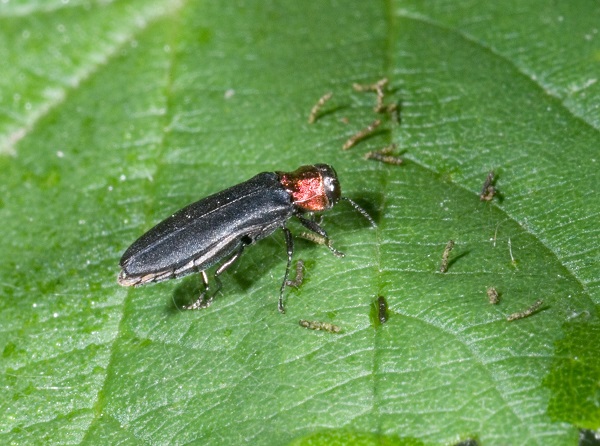Rednecked and Raspberry Cane Borers
ENTFACT-209: Rednecked and Raspberry Cane Borers | Download PDF
by Ric Bessin, Extension Specialist
University of Kentucky College of Agriculture
Rednecked Cane Borer
The rednecked cane borer can be a serious pest of raspberries and blackberries throughout Kentucky. Adult rednecked cane borers attack foliage, often feeding on the upper leaf surfaces during the day leaving irregular holes. Larvae feed on primocanes and form irregular swellings or galls. Galls are between 1 to 3 inches in length and often split the bark. Most galls are found at ground level but they maybe as much as 4 feet above the ground. Infested canes die or become so weakened they cannot support a crop the following season. Rednecked cane borers may infest as much as 50 percent of the canes in one or two year old plantings. Girdled canes are predisposed to winter injury.

Figure 1. Rednecked cane borer adult.
The rednecked cane borer adult is a small metallic wood-boring beetle. The slender adults are about 1/4 inch long; they are all black except for an iridescent coppery-red to golden thorax or "neck". Larvae are white, legless and are flattened just behind the head. They are between 5/8 to 3/4 inch long when mature and have a pair of dark-brown, toothed, forceps-like prongs. Pupae are about the same length and shape as adults.
The rednecked cane borers overwinter in canes as larvae. Larvae molt twice in the spring, then they excavate enlarged cavities in the cane. By mid to late May they shorten and pupate. Pupae molt to the adult stage by early June. They remain in the cane for 10 or more days; during this time they mature and chew a "D"-shaped exit hole to allow emergence from the cane. Rednecked cane borer adults emerge from canes in early June to mid June. They feed on the young primocane foliage for several days before laying eggs. Eggs are cemented to the cane, and hatch in four to 24 days, depending on temperature. Larvae chew into the cane and tunnel in a spiral fashion around the cane. Larvae normally tunnel upward into the pith, but tunnels may extend 6 inches below to 25 inches above the gall. When looking for overwintering larvae it is best to split the cane at the gall and follow the brown, discolored tunnel from the gall to its end. Live larvae are rarely found in the gall.
Observations on natural control of rednecked cane borer are mixed. However, research conducted in other states has reported as high as 75 percent natural mortality of rednecked cane borers in canes due to fungal diseases, parasitic wasps and unknown causes.
During winter pruning, growers need to determine the presence and extent of rednecked cane borer damage. If more than 10 percent of the primocanes are galled or the number of galled primocanes is greater than the number of canes you expect to prune out, control of this insect is advisable. Growers are encouraged to prune out galled canes and burn them before bud swell. Nearby sources of infestation should also be removed and burned during this dormant period. If parasitism is high it may be wise to leave pruned out cane in the planting to enhance the level of parasitism. If parasitism is low pruning and burning is probably better. If heavy rednecked cane borer infestations are not controlled by pruning and burning of galled canes, insecticidal control is suggested. Two insecticide applications, 7 to 12 days apart, timed to coincide with adult emergence, June through early July, will provide helpful control. Do not spray until adult emergence has been observed in your area.
Raspberry Cane Borer
Attack by the raspberry cane borer on blackberry, raspberry and rose results in tip die back and cane death.
Damage is readily identified with this insect by two rings of punctures about 1/2 inch apart and located 4-6 inches below the growing tip. These girdles cause the tip to wilt. Damage becomes more profound as the larva burrows to the base of the cane, causing the entire cane to die before the fruit matures.

Figure 2. Raspberry cane borer damage.
The raspberry cane borer is a slender long-horned beetle measuring about 1/2 inch long. It is black in color except for a yellow-orange thorax with two or three black dots and has long antennae. The elongate, cylindrical, legless larva is white and attains a length of nearly 3/4 inch.
Raspberry cane borer adults appear about June and after puncturing the two rings in the canes, lay an egg between the rings. These hatch in July and the larva begins burrowing towards the base of the cane and overwinters about 2 inches below the girdling. The second season it continues to burrow downwards to ground level where it spends the winter. It emerges as an adult the following spring.
The planting should be examined weekly during June and July. The existence of wilting tips characterized by the two rings described earlier identify attack by raspberry cane borer. Control is obtained by pruning out the infested canes by cutting a few inches below the oviposition rings or below the larval tunnel.
Revised: 11/19
CAUTION! Pesticide recommendations in this publication are registered for use in Kentucky, USA ONLY! The use of some products may not be legal in your state or country. Please check with your local county agent or regulatory official before using any pesticide mentioned in this publication.
Of course, ALWAYS READ AND FOLLOW LABEL DIRECTIONS FOR SAFE USE OF ANY PESTICIDE!
Photos courtesy Ric Bessin, University of Kentucky Entomology
